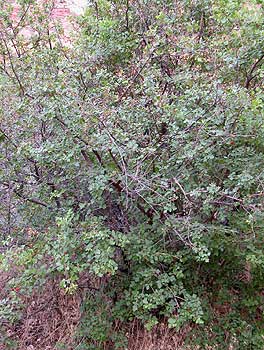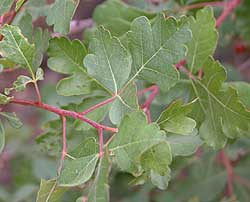 Skunkbush
Skunkbush
Rhus trilobata Nutt.
Common Names
Skunkbrush, polecat bush, stinking sumac, ill-scented sumac, quailbush, squawbush,
squawberry, basketbush, lemonade sumac, three-lobed sumac, three-leaved sumac, lemita
Uses
Ethnobotanic: Skunkbush fruits were used by Native Americans in foods, beverages, and
medicines. Pliable young stems were woven with grass stems into durable baskets that
would hold water. The leaves are said to have been smoked by the Comanches.
 Wildlife & Livestock: Livestock in some locations use skunkbush, but it is not a
preferred species. It has been planted in some locations as a deterrent to grazing
animals. It provides some browse for deer, elk, and pronghorn when more preferred
forage is unavailable. Skunkbush fruits, which persist through fall and winter, provide
a food for birds and small mammals when other foods are scarce or unavailable.
Skunkbush also may form dense thickets that provide good hiding and nesting cover
for small birds and mammals.
Wildlife & Livestock: Livestock in some locations use skunkbush, but it is not a
preferred species. It has been planted in some locations as a deterrent to grazing
animals. It provides some browse for deer, elk, and pronghorn when more preferred
forage is unavailable. Skunkbush fruits, which persist through fall and winter, provide
a food for birds and small mammals when other foods are scarce or unavailable.
Skunkbush also may form dense thickets that provide good hiding and nesting cover
for small birds and mammals.
Conservation: Skunkbush has been used as an ornamental (the fall leaves turn bright yellow, orange, and red to reddish-purple), and it has been widely planted at recreation sites, rest areas, and roadsides. It is useful for windbreaks, shelterbelts, and because of the strong root development, for erosion control. Var. trilobata has been successfully transplanted onto phosphate mine spoils in Idaho. 'Bighorn,' a cultivar from Wyoming, has been widely planted on pinyon-juniper sites, and the species has been successfully transplanted in aspen-maple, pinyon-juniper, and mountain-brush zones.

|
| Squawbush leaves. |

|
| Squawbush berries. |
General: Sumac family (Anacardiaceae). Upright arching native shrubs 0.5-2.5 meters tall, forming rounded, moundlike, or upright thickets, crown diameter often greater than the plant height; roots deep and extensively branched, with woody, shallow, and spreading rhizomes, sometimes connecting shrubs more than 9 m apart; sprouts arising from rhizomes and root crown. Leaves: deciduous, alternate, compound with 3 leaflets, variable in size, shape, lobing, and margin, the leaflets unstalked, ovate to rhomboid, more or less wedge-shaped at the base, coarsely-toothed, usually shiny-glabrous above, the terminal leaflet 3-6.5 cm long; summer foliage green, becoming orange or reddish in the fall. Flowers: yellowish to whitish, in small, dense clusters on short lateral shoots, opening before the leaves, bisexual and unisexual, both types borne on the same plant (the species polygamodioecious); male (staminate) flowers in yellowish catkins, female (pistillate) flowers in bright yellow, short clusters at the ends of branches. Fruits: 5-7 mm in diameter, red at maturity and sparsely hairy, each containing a single nutlet. Rhus trilobata closely resembles R. aromatica and is often treated as part of the latter. The common name is derived from the odor of the leaves, especially when bruised.
Variation within the species: a number of ecotypes are known to occur in skunkbush. Growth form and height vary geographically - plants are more branched and compact in the Southwest and taller in the north part of the range. Current practice recognizes six formal varieties, distinguished by morphological characteristics such as growth form, height, leaf shape and size, fruit shape and pubescence, commonly intergrading where they occur together.
- Var. anisophylla (Greene) Jepson - OR, CA, NV, UT, AZ, and NM, south into Mexico.
- Var. pilosissima Engelm. - CA to TX, south into Mexico.
- Var. quinata (Greene) Jepson - OR, CA, NV, AZ, and NM.
- Var. racemulosa (Greene) Barkl. - AZ and NM, south into Mexico.
- Var. simplicifolia (Greene) Barkl. - OK, CO, and NM, to CA and OR, south to AZ and Mexico.
- Var. trilobata - covers the range of the whole species.
Distribution: Broadly distributed throughout the western North America, from Saskatchewan and Alberta south to Texas and California and into Mexico; not in Washington or British Columbia.
Adaptation
Skunkbush grows in prairies to shrublands and oak woodlands at elevations of about
1000-3000 meters and in a variety of sites including dry rocky slopes, streamsides,
seasonal drainages, and canyon bottoms, sand dunes and sandhills, pastures, roadsides,
and waste places -- in sun or partial shade and over a wide range of soils from nearly
bare rock to sand and heavy clay. It is intolerant of flooding and high water tables.
Skunkbush is a prominent species in many early seral communities, especially after fire,
but it also is an indicator of climax in various shrub and grassland communities.
Flowering: April-July; fruiting: June-October, then persisting through the winter
if not eaten.
Establishment
Skunkbush produces seed nearly every year, but the number of flowers that produce fruit
is relatively low. Branches 6-10 years of age produce the most viable fruit. Mostly
birds and mammals disperse seeds. Roadside colonies frequently originate from
germination of seed in caches of mice and squirrels. Skunkbush, like other species of
Rhus, may be an effective seedbank former, with long-lived seeds stored in the humus
layer. The seeds have dormancy broken by cold treatment. Seedlings are intolerant of
crowding, even under optimal conditions. Growth of skunkbush is most rapid during the
first 3-5 years, and plantings have remained healthy and vigorous for more than 20 years;
healthy rhizomes have been aged at more than 30 years.
Management
Skunkbush sprouts vigorously from woody rhizomes or from adventitious buds at the root
crown after top-kill by fire. Crown width and overall coverage often increase in response
to fire. Skunkbush also may have the ability to delay sprouting for up to a year
following fire.
Skunkbush can be propagated from root and softwood cuttings - most effectively done well before freezing weather. Best seed germination is from fall and winter planting. The presence of seeded grasses has reduced the survival of skunkbush at some sites, and although the plants are generally drought-tolerant, water-stressed seedlings may be stunted for several years and sometimes fail to recover. Skunkbush is generally reported to be tolerant of heavy grazing.
References
Sanford, R.C. 1970. Skunk bush (Rhus trilobata Nutt.) in the North Dakota Badlands:
Ecology, phytosociology, browse production, and utilization. Ph.D. diss., North
Dakota State Univ., Fargo, North Dakota.
Tirmenstein, D.A. 1987. Rhus trilobata. IN: W.C. Fischer (compiler). The fire effects information system [Data base]. U.S.D.A., Forest Service, Intermountain Research Station, Intermountain Fire Sciences Laboratory, Missoula, Montana.
Wasser, C.H. 1982. Ecology and culture of selected species useful in revegetating disturbed lands in the West. FWS/OBS-82/56. U.S. Department of the Interior, Fish and Wildlife Service, Washington, DC.